Study provides the first preliminary analysis of various production, employment and investment scenarios
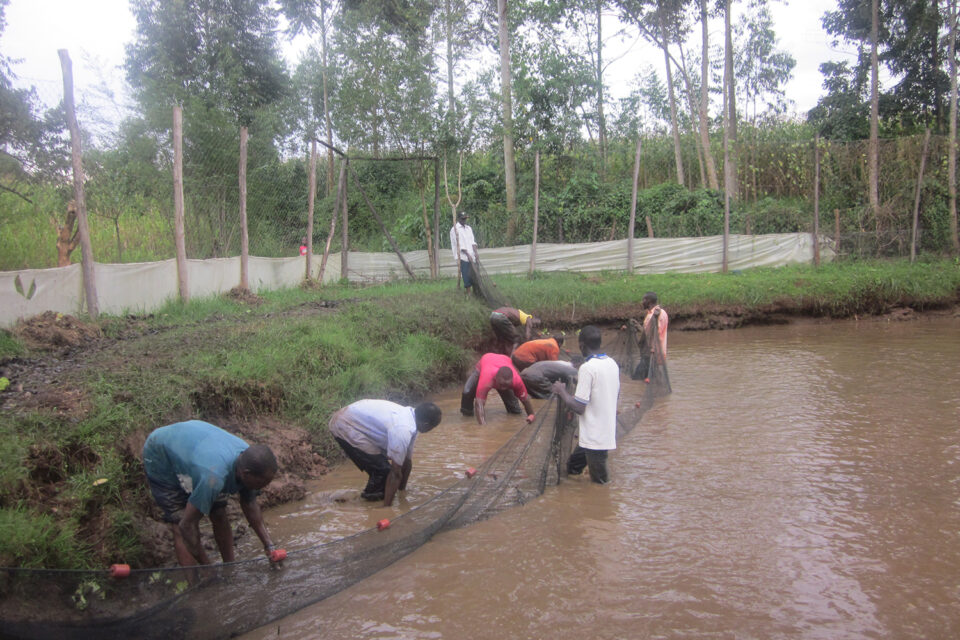
Ensuring that a healthy and sustainable diet is available to 2.4 billion Africans by 2050 is one of the most pressing challenges facing Africa’s food systems. The continent has struggled with a series of interconnected development challenges, particularly in fighting chronic food insecurity and overcoming pervasive poverty – the two foundational Sustainable Development Goals.
In Africa’s food systems, fish and other aquatic foods play a multifaceted role as a way of life, generating income and providing a critical source of essential micronutrients, particularly for women and infants. Nevertheless, the current and future values of fish and aquatic foods in Africa are often overlooked in development research, policy and investment. It is argued that this oversight means multiple pathways to address malnutrition and food insecurity are underexplored.
Fish consumed in Africa are predominantly provided by capture fisheries sourced from rivers, large inland lakes and coastal systems. Whereas aquaculture is one of the fastest-growing food production sectors globally, Africa contributed only 2.7 percent to the global aquaculture share in 2019. Nevertheless, the African aquaculture sector is maintaining double-digit average annual growth rates in the last two decades in response to increasing fish demand in the continent. Despite this growth, capture fisheries and aquaculture do not supply sufficient fish and there is a significant gap between fish supplies and consumer demand in Africa.
Further, the fish supply gap is projected to widen due to a dramatic increase in fish demand, driven by rapid population and income growth, diet transformation resulting from urbanization and changing consumer preferences. In addition, Africa hosts regions that are amongst the most susceptible to global climate change. In sum, there are growing uncertainties and daunting challenges associated with the future of Africa’s food systems associated with large-scale drivers that operate outside and within fisheries and aquaculture systems.
These challenges, amplified by the unprecedented COVID-19 pandemic, have led the governments of African and regional organizations to determine the potential investment opportunities and interventions in fisheries and aquaculture to address food and nutrition security. To date, there are no estimates of investment and potential returns for domestic fish production in Africa.
This article – adapted and summarized from the original publication (Chan, C.Y. et al. 2021. The future of fish in Africa: Employment and investment opportunities) – reports on a study to contribute to policy debates about the future of fish in Africa, based on two scenarios we developed: business-as-usual (BAU) and high-capture fisheries and aquaculture with stronger GDP growth (HIGH).
Raise the flag: South African veterinarian develops three-tiered tilapia-health system
Study setup
In our study, we first projected future fish supply and demand in Africa to 2050 using the International Model for Policy Analysis of Agriculture Commodities and Trade (IMPACT).
The IMPACT fish model was developed by International Food Policy Research Institute (IFPRI) and is a partial-equilibrium economic model containing a system of equations for analyzing baseline and alternative scenarios for fish demand, supply, trade and prices at global, regional and country level in responding to future changes such as income, population and technological progress.
We then conducted post-model analysis to extrapolate future potential direct (capture fisheries and aquaculture) and indirect employment that would be associated with the BAU and HIGH scenarios. Finally, we estimated future aquaculture production value and investment costs required to achieve BAU and HIGH scenarios.
Our study focused on eight African nations: Egypt, Ghana, Kenya, Malawi, Nigeria, Tanzania, Uganda and Zambia. We selected these countries because they are 1) nations projected to face the largest shortfalls in fish supply relative to demands; 2) experience high rates of fish consumption; and 3) are amongst the nations experiencing relatively rapid growth in aquaculture.
These eight countries are home to 40 percent of Africa’s total population but produce over 95 percent of aquaculture and 30 percent of capture fisheries production (by volume) in the continent in 2019. About half of fish consumed in Africa is by these eight countries, suggesting slightly higher per capita fish consumption rates than elsewhere in Africa. Among these eight countries, Uganda, Tanzania, Malawi, Kenya and Ghana are classified by Food and Agriculture Organization (FAO) as low-income, food-deficit countries.
For detailed information on the models used in the study, and the databases used and other sources of information for the models, refer to the original publication.
Results and discussion
One of Africa’s biggest development challenges is to meet the nutrition needs, within sustainable limits of 2.4 billion women, men and children by 2050. Experiences in Asia and other regions show that aquatic foods, capture fisheries and aquaculture systems offer important nutritional and sustainability values, in some cases outperforming nutritional qualities of dietary supplements and a relatively lower environmental footprint than animal-source foods. However, the role of fisheries, aquaculture and aquatic foods in the transformation of food systems has remained relatively overlooked due to the lack of scientific data, metrics and evidence to inform donors, governments and private investors in decision making and investment planning.
There is a global concern that current food systems are ill-equipped to deliver nutritious food, a challenge that will be exacerbated as demands of burgeoning populations and wealth will outpace supplies. In practice, limited supplies of quality food will affect different people to different degrees based on their economic status, geography and gender, with women of reproductive age and children under the age of 5 being most vulnerable to nutrient deficiencies. Our BAU scenario projection shows that per capita fish consumption in Africa will gradually drop from 10.0 kg per person per year (about half the global and Asian fish intake) in 2015 to 7.7 kg in 2050.
The drop in fish consumption we see in our BAU scenario is a result of population growth outpacing growth in the fish sector. Decreasing per capita fish consumption is also the outcome of modest GDP growth. Lower economic growth will constrain the ability of governments and the private sector to invest in supply infrastructure, technology and management systems that might otherwise boost supplies.
In the optimistic HIGH scenario, with GDP growth at 4.8 percent per year to 2050, per capita fish consumption is projected to increase from 10.0 kg/year in 2015 to 14.0 kg/year in 2050. Investments in sustainable fisheries management and aquaculture will boost total domestic production to 34.8 million metric tons (MT) in 2050, of which the share of capture fisheries in total fisheries production in Africa will decline from 82.7 percent in 2015 to 46.0 percent in 2050.
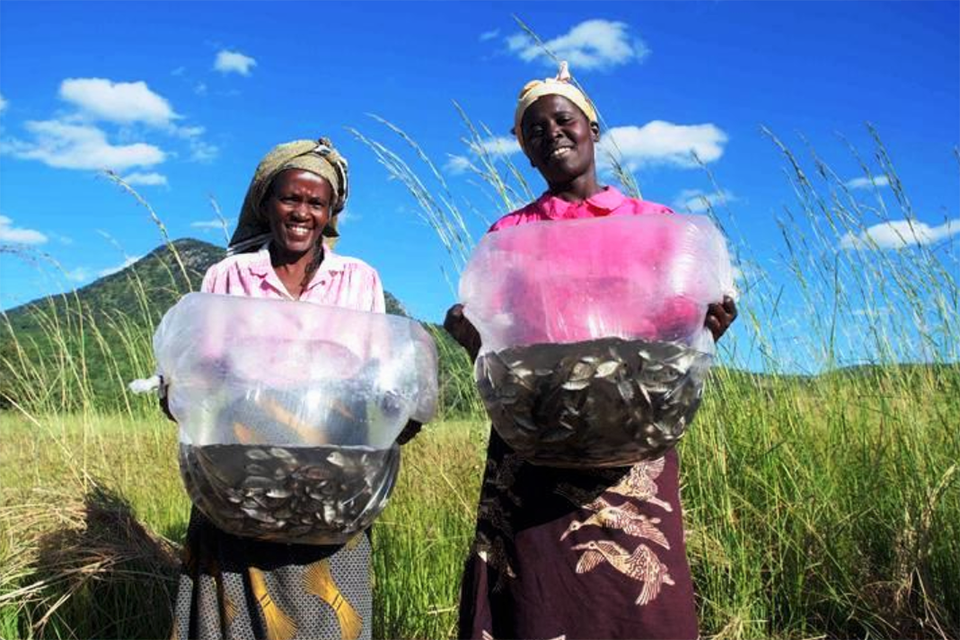
These results show that there is potential to sustain capture fisheries and expand aquaculture to meet the growing demand for fish in Africa. This requires a sound, enabling macro-environment, particularly moderate to high-economic growth, to stimulate fish demand increase and sustained investment from farmers, investors and governments to transform Africa’s capture fisheries and aquaculture into sustainable, productive, nutrition-sensitive and inclusive aquatic food systems.
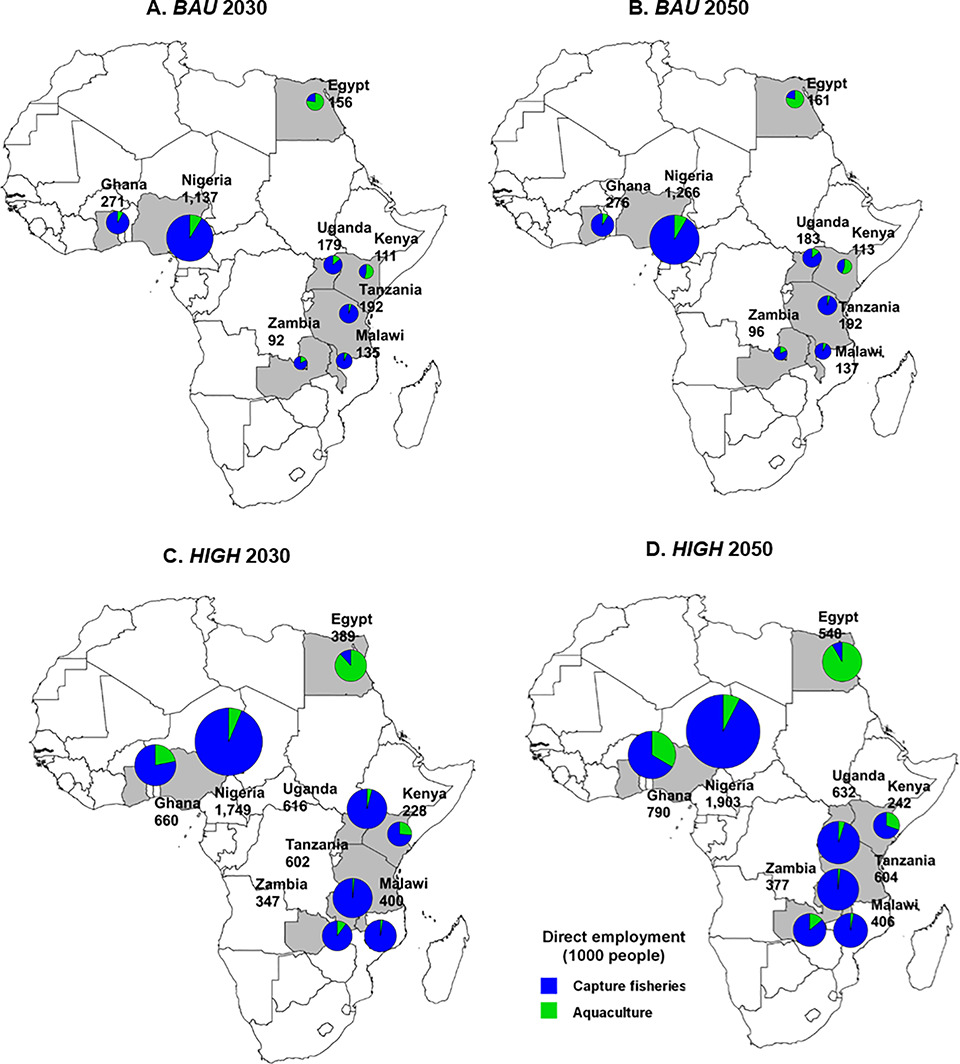
Youth employment, and the future employment of current youth, is a growing opportunity and concern globally and aquaculture and fisheries offer possible but evolving opportunities. With rapid population growth and a young population (60 percent of the African population are below the age of 25), it is expected that 11 million young people will enter the job market in sub-Saharan Africa every year, while only about 3 million new jobs are created annually on the continent. Both capture fisheries and aquaculture are important sources of employment in Africa, particularly for smallholders and value chain actors in rural areas. Creating jobs in rural areas at a large scale is critical to address these unemployment issues and income generation in Africa.
Our study results show that under the BAU scenario, with slow aquaculture growth and almost stagnant capture fisheries, Africa’s fish sector is projected to provide 22 million direct and indirect jobs by 2050. However, with the HIGH scenario, 58 million people will be directly and indirectly employed in fisheries and aquaculture sectors, representing 2.4 percent of the total projected population in Africa in 2050. The projection results indicate that growth in Africa’s fish sector will create considerable employment and has the potential to generate significant income growth and facilitate inclusive value chain development to address development barriers faced by Africa.
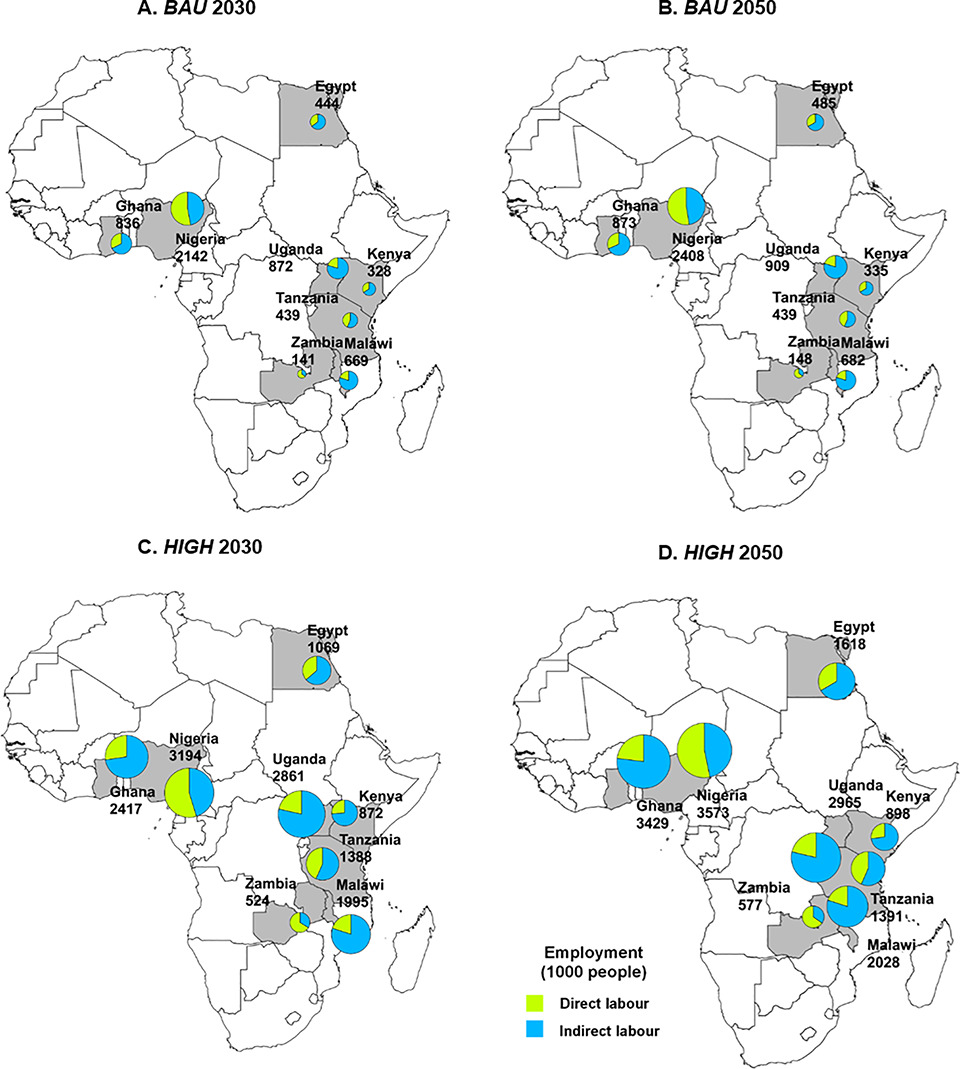
Our projection estimated that the overall African labor productivity of direct employment in both capture fisheries and aquaculture is 2.0 MT per worker, slightly lower than the world average. Furthermore, employment in the fish sector in Africa will continue to be dominated by small-scale fisheries, with lower labor productivity compared to aquaculture (1.7 MT per worker vs. 6.3 MT per worker). This result highlights the importance of sustainable capture fisheries management to generate employment opportunities and provide income for the portion of the African population depending on artisanal fishing. In order to achieve the desired sustainability transformation, public policy leadership and private sector technological innovation will be required.
Our projections also show that strong aquaculture growth has a high potential to generate income and jobs for rural communities in Africa. Under the HIGH scenario, aquaculture production in Africa is projected to reach 18.8 million tons, generating revenue of (U.S.) $20.4 billion in 2050. Projected farm-gate investment costs of three key aquaculture inputs (feed, labor and fish seed) will reach $11.6 billion in 2050.
It is essential to highlight that these investments can be mobilized from farmers, private sector investors and enterprises, suggesting dynamic opportunities for market-led aquaculture business development. Given that feed accounts for a major share of aquaculture production cost, this suggests that there will be bright prospects for investing in the aquaculture feed industry in Africa. It will be essential to have more supportive policies and regulations to serve as an entry point for the private sector on more inclusive ways to engage smallholders in the fish value chains.
Our study provides useful insights on how aquatic foods, fisheries and aquaculture systems in Africa might evolve into the future under complex and dynamic interactions of structural changes, technological progress, income growth and urbanization in a climate crisis. Our findings also allow drawing policy implications of different impact pathways, drivers and interventions to enhance aquatic food systems’ contributions to sustainable development goals in Africa. As documented in a previous report, these results could be the practical usage by a wide range of stakeholders from international organizations, academics and national governments.
Perspectives
Our current food systems face severe challenges in achieving equitable access to healthy, nutritious food, maintaining environmental sustainability and building resilience to shocks. Fish and aquatic foods offer significant potential in the transformation of food systems toward healthy and sustainable diets, sustaining livelihoods and generating income.
The fish sectors are important for employment creation in Africa, yet their role has been overlooked, resulting in insufficient investment to support the sector growth and sustainable system transformation to meet the increasing demand for fish. This study provides insights into future fish supply and demand projections in Africa under the BAU and HIGH scenarios and provides first estimates of employment generated and the necessary input cost investments required to secure projected fish supplies in 2030 and 2050.
Although our study does have limitations that should be addressed in the future, nevertheless it is a key and first preliminary analysis to look at macro-level employment and investment scenarios of fish sectors in Africa.
Now that you've reached the end of the article ...
… please consider supporting GSA’s mission to advance responsible seafood practices through education, advocacy and third-party assurances. The Advocate aims to document the evolution of responsible seafood practices and share the expansive knowledge of our vast network of contributors.
By becoming a Global Seafood Alliance member, you’re ensuring that all of the pre-competitive work we do through member benefits, resources and events can continue. Individual membership costs just $50 a year.
Not a GSA member? Join us.
Authors
-
-
Nhuong Tran, Ph.D.
WorldFish
Penang, Malaysia -
Kai Ching Cheong, M.S.
WorldFish
Penang, Malaysia -
Timothy B. Sulser, Ph.D.
International Food Policy Research Institute
Washington, DC, USA -
Philippa J. Cohen, Ph.D.
WorldFish
Penang, Malaysia -
Keith Wiebe, Ph.D.
International Food Policy Research Institute
Washington, DC, USA -
Ahmed Mohamed Nasr-Allah, Ph.D.
WorldFish
Sharkia, Egypt
Tagged With
Related Posts
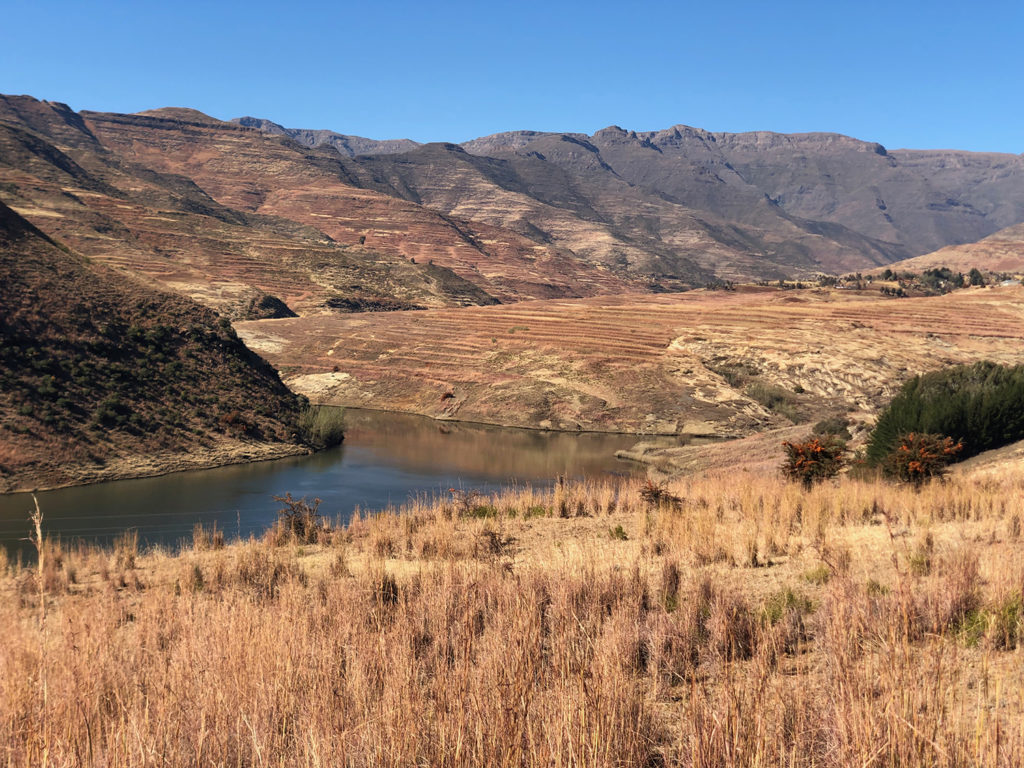
Innovation & Investment
Africa’s first land-based salmon farm a landmark for Lesotho
A Singapore-based company aims to make Lesotho, a nation of 2 million people, known for a local fish that’s truly anything but local: Atlantic salmon.
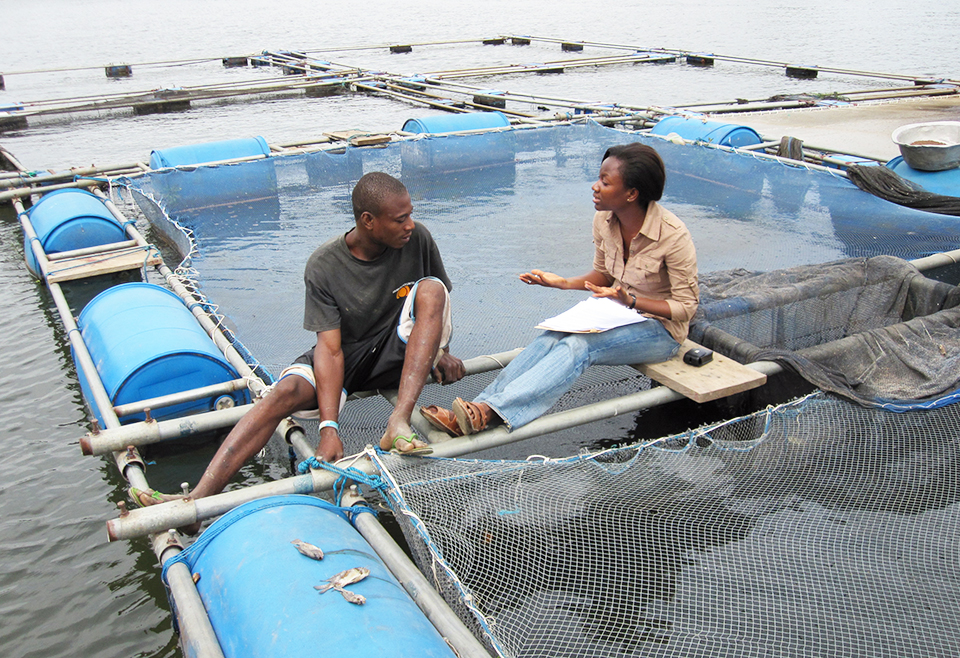
Health & Welfare
A look at tilapia aquaculture in Ghana
Aquaculture in Ghana has overcome its historic fits and starts and is helping to narrow the gap between domestic seafood production and consumption. Production is based on Nile tilapia.
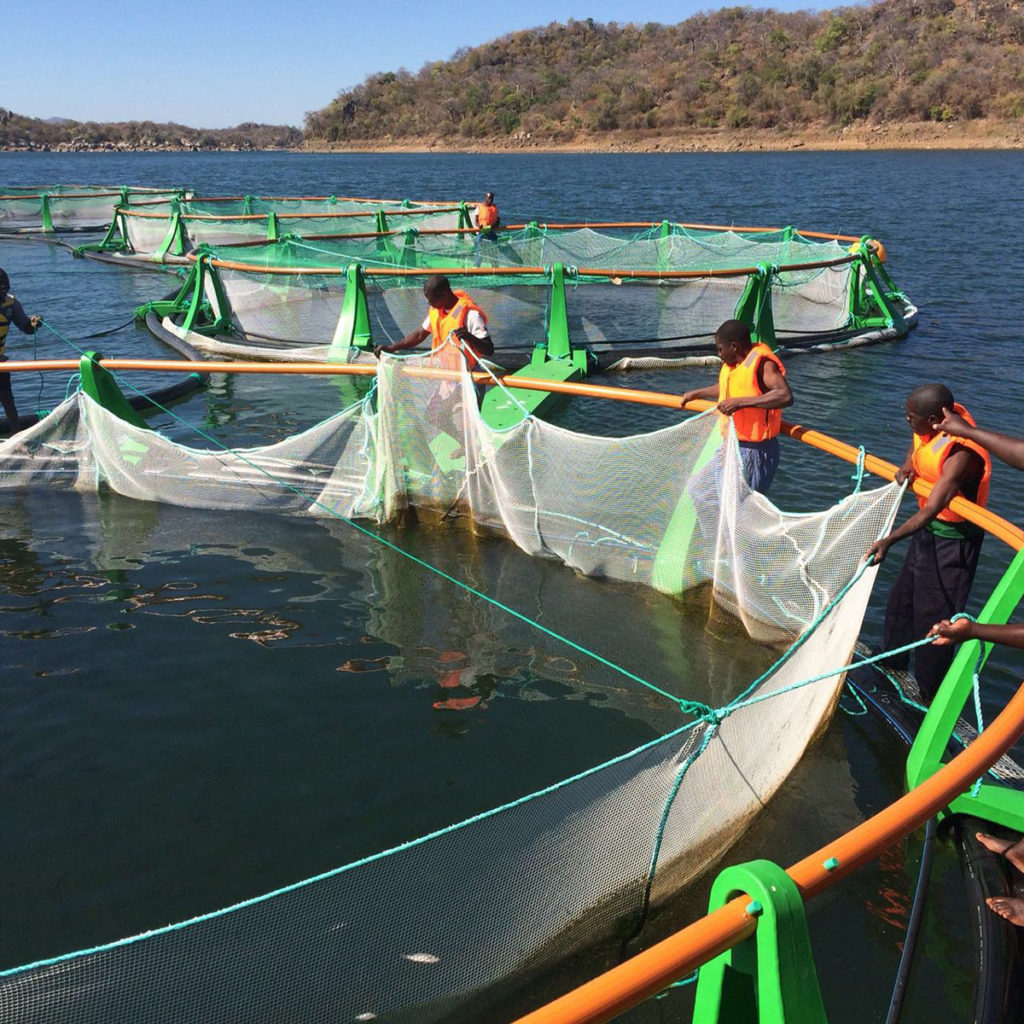
Responsibility
‘Model’ tilapia venture shows mettle in Mozambique
On the shores of Lake Cahora Bassa, Chicoa Fish Farm hopes to create a ripple effect to improve fish supply and quality of life for an impoverished region.
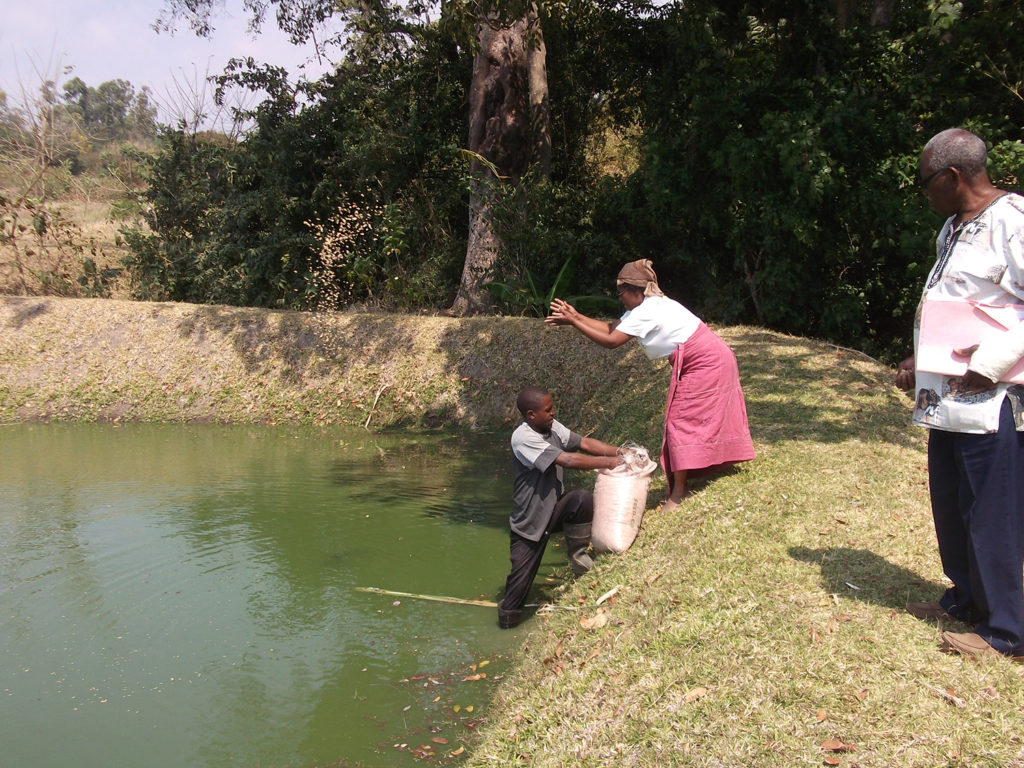
Innovation & Investment
Investing in Africa’s aquaculture future, part 1
What is the future that Africa wants? Views on how to grow aquaculture on the continent vary widely, but no one disputes the notion that food security, food safety, income generation and job creation all stand to benefit.



